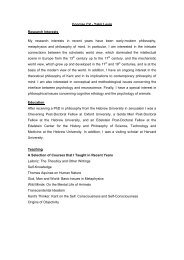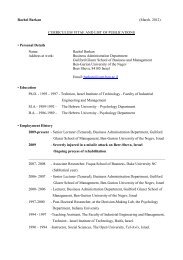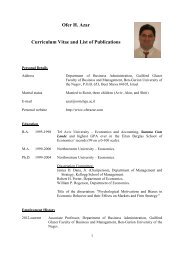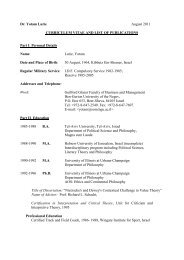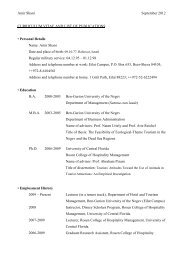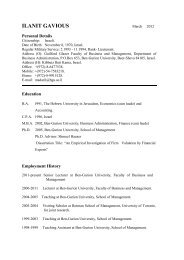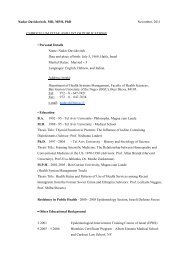Book of Abstracts
Book of Abstracts
Book of Abstracts
You also want an ePaper? Increase the reach of your titles
YUMPU automatically turns print PDFs into web optimized ePapers that Google loves.
44<br />
schools in Cyprus as a tool to study issues related to desertification and climate change while elaborating on an ideal<br />
schoolyard model as an effective field approach in primary education.<br />
Methods: The study was conducted in 15 primary schools in Cyprus, and the data collection included quantitative<br />
and qualitative methods. Specifically, a questionnaire was administered to 100 teachers, while interviews were<br />
conducted with 15 other teachers. Characteristics <strong>of</strong> elementary schoolyards were also recorded using observations.<br />
Results: The analysis <strong>of</strong> the results revealed that the current schoolyards in primary schools <strong>of</strong> Cyprus are virtually<br />
neglected sites and rather hostile to the students. The majority <strong>of</strong> teachers believe that the use <strong>of</strong> the schoolyard<br />
depends entirely on the personal interest and initiative <strong>of</strong> individual teachers. Using the schoolyard as a learning tool<br />
for environmental issues and sustainable development (desertification, land degradation, biodiversity, etc.) is <strong>of</strong><br />
secondary importance and <strong>of</strong> limited use in some courses, such as science, for conducting soil and climate change<br />
experiments. Finally, as significant barriers to the utilization <strong>of</strong> the schoolyard, teachers emphasized the lack <strong>of</strong><br />
practical and experiential training and content knowledge <strong>of</strong> the above issues, the lack <strong>of</strong> time to transfer the<br />
learning to the field and the extra burden on an already busy schedule. The results are discussed in relation to the<br />
pedagogical frameworks <strong>of</strong> EE and the ESD, as well as in relation to the didactic and methodological framework for<br />
examining issues related to desertification and soil degradation.<br />
Evolution, Climate and Man as Factors Leading to Degradation and<br />
Productivity Loss in Terrestrial Biomes<br />
Hot deserts are found at the lower extreme <strong>of</strong> the terrestrial biomes productivity gradient where tropical<br />
forests and temperate forest are found on the upper one. In order to understand the function <strong>of</strong> the desert<br />
we need a general theory on the structure <strong>of</strong> terrestrial biomes and the relation between productivity and<br />
biome’s structure. Currently, there are 3 non-exclusive models explaining this relation, namely (a) a fixed<br />
structure (Hairston, Smith et al. 1960) HSS “The green world theory”), (b) an increase in the number <strong>of</strong><br />
trophic levels with productivity and desert having the lowest productivity has only one trophic level<br />
((Oksanen and Oksanen 2000) and (c) a decreasing number <strong>of</strong> trophic levels with productivity and deserts<br />
have four ((Ayal 2007; Ayal 2011).<br />
These three different theories were developed by scientists working in different biomes, the first working<br />
in temperate forest, the second working in grasslands and tundra whereas the third working in deserts.<br />
The proposed session will bring representatives <strong>of</strong> the 3 groups to try to unify the theories and through it<br />
understand how terrestrial biomes work and especially arid ones: hot deserts, dry grasslands and cold<br />
deserts (tundra). This is essential for understanding how biomes structure will change due to climate<br />
change, especially the expected increase in aridity, the way to preserve arid biomes.<br />
From evolutionary to anthropomorphic habitat degradation: a lesson from past cycles <strong>of</strong><br />
“desertification” to the present crises<br />
Yoram Ayal; Department <strong>of</strong> Ecology; Ben-Gurion University <strong>of</strong> the Negev, Israel; ayal@bgu.ac.il<br />
Desertification is the process <strong>of</strong> degradation <strong>of</strong> the landscape in drylands. It is <strong>of</strong>ten a consequence <strong>of</strong> human<br />
activities and reduces the future economic use <strong>of</strong> the land. The main factor currently driving this process is the<br />
increase in human population size. This leads to over-exploitation <strong>of</strong> the environment, which not only reduces<br />
production per se, but also results in detrimental changes in the landscape that make it difficult, or even impossible,<br />
to recover past production. These processes are expected to be further enhanced by anthropomorphic global climate<br />
changes. However, these processes are not new and, in part, are rooted in past evolutionary changes <strong>of</strong> the<br />
landscape resulting from animal, manly herbivore, population growth that lead to over-exploitation <strong>of</strong> their food<br />
resources. This, with the aid <strong>of</strong> a changing climate, the landscape was degraded and the animals' food resources<br />
reduced.



